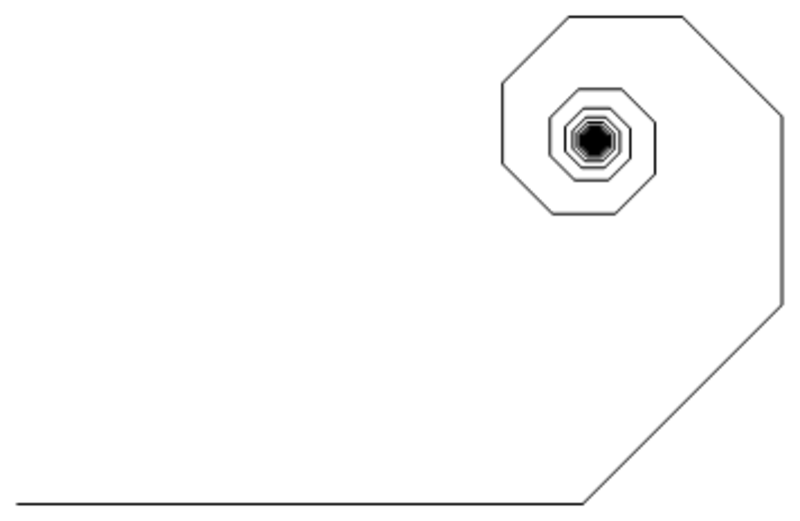The Crazy Ant

A crazy ant is standing on the origin. It begins by walking 1 unit in the + x -direction and then turns 4 5 ∘ counterclockwise and walks 2 1 units in that direction. The ant then turns another 4 5 ∘ and walks 3 1 units in that direction. The ant keeps doing this endlessly. How far is the ant's final position from its initial position?
The answer is 1.20806.
This section requires Javascript.
You are seeing this because something didn't load right. We suggest you, (a) try
refreshing the page, (b) enabling javascript if it is disabled on your browser and,
finally, (c)
loading the
non-javascript version of this page
. We're sorry about the hassle.
3 solutions
Same approach! Small correction only. In the last step, the exponent after the ln should have 2 ln ( 2 − 2 ) under. You missed the 2 . It doesn't affect ∣ Z ∣ , just a small detail.
The displacements in the E-direction are 1 − 5 1 + 9 1 − 1 3 1 + . . . = 4 ∑ n = 0 ∞ ( 8 n + 1 ) ( 8 n + 5 ) 1 = 4 2 π + ln ( 3 + 2 2 ) = 0 . 8 6 6 9 7 2 9 8 . . . = A
The displacements in the NE-direction are 2 1 − 6 1 + 1 0 1 − 1 4 1 + . . . = 4 ∑ n = 0 ∞ ( 8 n + 2 ) ( 8 n + 6 ) 1 = 8 π = 0 . 3 9 2 6 9 9 0 8 . . . = B
The displacements in the N-direction are 3 1 − 7 1 + 1 1 1 − 1 5 1 + . . . = 4 ∑ n = 0 ∞ ( 8 n + 3 ) ( 8 n + 7 ) 1 = 4 2 π − 2 ln ( 1 + 2 ) = 0 . 2 4 3 7 4 7 7 4 . . . = C
The displacements in the NW-direction are 4 1 − 8 1 + 1 2 1 − 1 6 1 + . . . = 4 ∑ n = 0 ∞ ( 8 n + 4 ) ( 8 n + 8 ) 1 = 4 ln ( 2 ) = 0 . 1 7 3 2 8 6 7 9 . . . = D
The total net displacement in the positive x-direction is Δ x = A + 2 1 2 ( B − D ) = 1 . 0 2 2 1 2 1 4 1 . .
The total net displacement in the positive y-direction is Δ y = C + 2 1 2 ( B + D ) = 0 . 6 4 3 9 6 0 1 8 . .
The overall net displacement is ( Δ x ) 2 + ( Δ y ) 2 = 1 . 2 0 8 0 6 3 2 8 . . .
How did you calculate those infinite sums?
Fourier series can also be used once you get the distance interms of sinnx/n series ,cosnx/n series.
Consider the plane the crazy ant walks on be a complex plane. The ant starts at the origin 0 + 0 i . A turn of 4 5 ∘ anticlockwise is equivalent to multiplying by e 4 π i . Therefore, the spiral walked by the ant can be expressed as:
Z = 1 + 2 e 4 π i + 3 e 2 π i + 4 e 4 3 π i + ⋯ = e − 4 π i ( e 4 π i + 2 ( e 4 π i ) 2 + 3 ( e 4 π i ) 3 + 4 ( e 4 π i ) 4 + ⋯ ) = − e − 4 π i ln ( 1 − e 4 π i ) = − e − 4 π i ln ( 1 − 2 1 − 2 i ) = − e − 4 π i ln ( 2 − 2 ⋅ e − i tan − 1 ( 2 + 1 ) ) = − e − 4 π i ( 2 ln ( 2 − 2 ) − i tan − 1 ( 2 + 1 ) ) = e − 4 π i ⎝ ⎛ 4 ln 2 ( 2 − 2 ) + ( tan − 1 ( 2 + 1 ) ) 2 e − i tan − 1 ln ( 2 − 2 ) 2 tan − 1 ( 2 + 1 ) ⎠ ⎞ By Maclarin series
The distance between the ant's final and initial positions is given by ∣ Z ∣ = 4 1 ln 2 ( 2 − 2 ) + ( tan − 1 ( 2 + 1 ) ) 2 ≈ 1 . 2 0 8 .
Reference: Maclaurin series